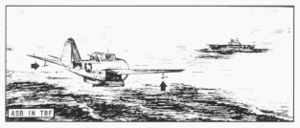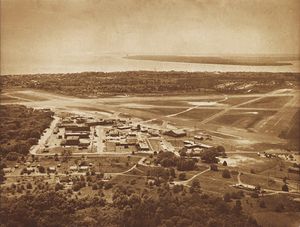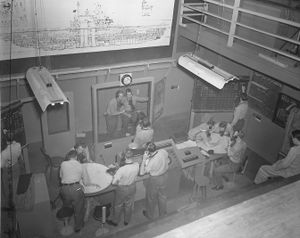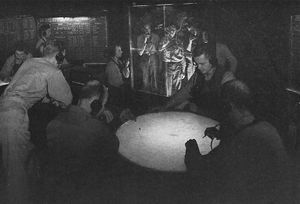The Night Fighters - Chapter 11 of Radar and the Fighter Directors
By David L. Boslaugh, Capt USN, Retired
Development of USN Airborne Radar
The first USN airborne radars were either borrowed British Air to Surface Vessel (ASV) sets, Airborne Intercept (AI) sets, or copies thereof by American manufacturers. In 1941 the Bureau of Aeronautics tasked the Naval Research Laboratory to develop an airborne search radar. To steal a march in time, the Lab converted an already developed 515 MHz (0.58 meters wavelength) radio altimeter to search use. The radar, designated XAT, took form with two directional Yagi antennas mounted under the wing tips on either side of the aircraft. The two antennas could be pointed abeam to search a path twenty-five miles wide on either side of the plane, or they could be pointed ahead and slightly overlapping for homing on a target. The receiver switched at a high rate between the two antennas, and the returns from the two showed up as two pips projecting right and left from a vertical time base line. Their position on the vertical line indicated range. In the homing mode, the pilot pointed the plane until the pip strengths were equal, meaning he was headed directly at the target. The radar was equally effective with air and surface targets.
From 1942 to 1944, RCA, Bendix Corp. and Westinghouse Electric Corp. were issued contracts to produce the radar, designated ASB, and in total, they produced more than 26,000 sets. This was the largest acquisition of any model WW II radar. The ASB became a workhorse airborne radar and was installed in a few early F4U-2 night fighter Corsairs as well as torpedo bombers, dive bombers, and patrol planes. In the bombers and patrol planes there was at least one crew member, other than the pilot, to operate the radar. In a single seat night fighter, operating the radar must have been a handful for the pilot. [23, pp.203-204]
On 18 April 1942, Project Affirm, a night fighter development unit, was established at Naval Air Station (NAS) Quonset Point, RI. Their mission was to develop and test night fighter equipment for USN and USMC aircraft. In addition they were to develop tactics and train officers and men for early night fighter squadrons and to train night fighter directors. Officers who had completed one of the basic fighter direction schools were sent here for advanced training. In May 1944 a second Project Affirm school was opened at NAS Barber’s Point on Oahu to train night fighter squadrons and night FDOs. [20, p.111] [13, p.43]
The British cavity magnetron was a natural for airborne radar because the centimeter wavelength not only allowed a much smaller antenna, but also brought about greatly improved range, bearing, and elevation accuracy as compared to meter wavelengths. The equipment could be made small enough that the antenna and most of the electronics, other than the display, could be mounted in a streamlined pod hung below a fighter wing or built into the front of a wing. One of the first radar developments of Project Affirm was done in conjunction with the MIT Radiation Laboratory and Sperry Gyroscope Co. who were contracted to design a radar more effective than the ASB and small enough to be fitted into a single seat night fighter. The Sperry radar, built around a three centimeter cavity magnetron, was designated AIA, and fitted into a pod mounted on the front of the right wing of the Corsairs of Night Fighting Squadron VF(N)-75, the first squadron to be trained by the night fighter development unit.
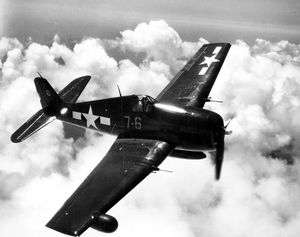
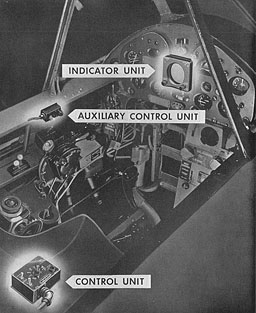
The AIA operated in two modes: search and gunsight. In search mode the small two-inch cockpit display showed range, bearing, and elevation of the target by means of a dot and its position relative to a baseline. Range was indicated as distance of the dot above the baseline, and bearing by position right or left of center. As range decreased, the signal split into two dots next to each other, of which the left-hand dot continued to represent range as distance above baseline, and bearing as distance to the right or left of scope center. The right-hand dot indicated target elevation as its distance above or below the left hand dot. At approximately one-half mile range, the pilot switched to gunsight mode, and the dot gave left-right and up-down steering directions. The set also had a beacon function that gave the pilot steering directions to return to his carrier. In January 1943, the Bureau of Ships issued a contract to Westinghouse Electric Corporation to design and manufacture an improved version of the AIA radar, to be designated AN/APS-6, deliveries of which began in March 1944. Many hundreds were produced and most went into Grumman F6F night fighters, with some going into Vought F4U night fighters. [24] [23, pp.204-205]
Establishment of the School
In 1935 the Glynn County, Georgia, Commission, recognizing the future importance of aviation to the county and the city of Brunswick, made the decision to establish a modern airport complete with paved runways on St. Simons Island about 15 miles from Brunswick. The new airport, named McKinnon Field, opened in 1938 and soon was soon served by scheduled air service and charter air services as well as attracting a number of private airplane owners. With the outbreak of World War II, Civil Air Patrol Coastal Patrol Unit 6 made McKinnon field their home base until the U. S. Navy bought the field in July 1942, and renamed it Naval Air Station St. Simons Island. The Air Station began its navy life as a training base for Grumman F4F “Wildcat” pilots, but a year later would have a new mission. [69] [68]
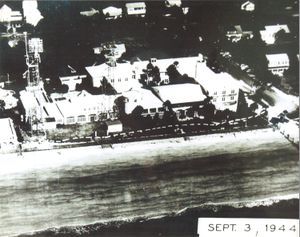
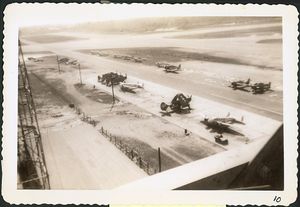
By March 1943, the Norfolk Fighter Director School was becoming overcrowded, and there was no room for expansion, in the face of an increasing need for trained fighter directors. The Vice Chief of Naval Operations and the Chief of the Bureau of Aeronautics recommended a new school be established large enough to meet all the fighter director needs of both the Navy and the Marine Corps. This was estimated at 25 marine officers and 100 naval officers per month. On 8 May 1943 the Chief of Naval Operations directed that the Norfolk FD School be relocated to Naval Air Station St. Simons Island, GA, and be named the Naval Radar Training School with a mission of training officers in combat information center operations and fighter direction. The Pearl Harbor Camp Catlin radar training school would be relegated to emergency replacement training and FD refresher training. [13, pp.43-44]
The U. S. Naval Radar Radar Training School began training Marine and naval officers in shore based and shipboard fighter direction five weeks later. The sole purpose of the aviation facilities and airplanes at the station would be to support the fighter direction training by providing live interceptors and “enemy raiders” for the school. Seven fully equipped combat information centers replicating the CICs in various ship types and classes were installed in newly constructed buildings, and were fed by live shipboard radars. More CICs and radars were located at off-field sites. [70,p.7] Teaching staff was initially composed of 49 officers, most of whom had been fleet fighter directors. One of the teaching staff would be an exchange instructor from Naval Air Station Yeovilton, England, the Royal Navy fighter direction school. On-board count of students would initially average 250, and attrition would average about 14%. [70, p.14]
By war’s end, the school would have an average of over 500 students at any one time, and the staff would include 440 officers, 131 civilian employees and 595 enlisted personnel. The Navy would return the airport, including numerous capital improvements, to Glynn County in 1947. [69]
The Curriculum
Four major courses were taught at NRTS St. Simons:
1. A three-month basic intercept training Long Course covering CIC operations and fighter direction. The graduates would have run about ten live intercepts from the CICs plus four outside visual intercepts
2. One-month Ship’s Officer’s Course This course would familiarize ship’s CIC officers with the principles of fighter direction but did not give Interceptor qualification. The fourth week was spent running live intercepts. A second month could be added for officers with CIC experience for training to qualify as Interceptor Second Class.
3. Refresher Course This course would be given to groups of ten or more Argus ground based fighter directors and/or experienced shipboard CIC officers. Average class size was 35. The first two-week orientation would familiarize former Argus officers with shipboard CIC operations and it would bring shipboard officers up to date with new technical and tactical developments. The next month would be spent in live intercept operations and would also familiarize the students with the functions and layouts of various shipboard CICs. Officers doing well in this course could be selected to be held over for the one-month Ground Controlled Intercept course described below.
4. The one-month Ground Controlled Intercept (GCI) Course could be added to the Long Course or the refresher course for officers who showed a marked aptitude for fighter direction. Night intercepts would be emphasized, and the finishing student would have done at least 50 intercepts on simulation trainers plus a minimum of 25 live intercepts. If class enrollment was small, students might conduct as many as 100 live intercepts. The SM three-dimensional radar would be used in most of the live night intercepts, and successful completion of this course qualified the student as Interceptor.[70, pp.8-11]
Training Night Fighter Directors
Special training, above and beyond that needed for daytime fighter direction, was required for the night fighter director because the problem was an order of magnitude more difficult. In daylight, the FDOs job was to bring the interceptor within a few miles of the target, and hopefully at a higher altitude. The main requirement was to be close enough for a visual contact after which the pilot took over. In a night intercept the FDO was expected to bring his fighter in astern of the bogey, headed in the same direction, flying just slightly faster, and slightly below the target. The goal was to get him close enough to detect the bogey on his intercept radar. If the pilot lost radar contact the FDO was to coach him back on. As an illustration of the challenges of night fighter direction, the Aircraft Control Manual states:
...the night controller must be explicit in his direction of the fighter. The confidence of the pilot in the night controller must be absolute, and this is accomplished only where the controller, having accepted responsibility for the control, has fitted himself to the job.
Because the pilot was essentially flying blind, the night controller had the added responsibilities of keeping the pilot out of the range of friendly gunfire and, if over land, keeping him clear of mountains and other obstructions. He had to keep his interceptor under positive control at all times, meaning he had to see the fighter on his radar and have constant two-way radio contact. If the FDO lost positive control he was to inform the pilot immediately. [52, p. 129]
The day controller had options of controlling from a plotting table or directly from a PPI scope, whereas night control was always to be done directly from the PPI, with a plotting assistant at a radar plotting table furnishing him the bogey’s course and speed as well as computed course and speed for intercept. This allowed the FDO to see the relative positions of his fighter and bogey simultaneously on one scope. The FDO was to provide headings as magnetic headings, and speeds and altitudes as indicated by aircraft cockpit instruments. If the FDO did not have height finding radar, he was enjoined to use the ship’s microwave fire control radar whenever the bogey was within fire control range. In night interceptions, the FDO would be giving more instructions at a higher rate than for day interceptions. Terminology had to be shortened and there was no time for exchanging long call signs. In his initial intercept vector, the FDO was to interject the word ‘”bogey” so the pilot would know it was not a drill or a patrol direction, but a live intercept. If there were long silent periods between transmissions, the FDO was to transmit at least once per minute to verify radio contact. The night director had to master three types of intercepts: curve of pursuit, cut-off vector, and the head-on intercept. The last was extremely demanding of skill because the interceptor had to meet the target with just the right offset to make a final turn, and the timing of the beginning of the turn was critical. [52, pp.131-138]
First Night Fighter Squadrons
The Marine Corp’s first night fighter squadron VMF(N)-531 was commissioned on 16 November 1942 at Marine Corps Air Station (MCAS) Cherry Point, NC, under the command of LTCOL Frank H. Schwable. After initial training with single-engine SNJ advanced trainers and then with single-engine SB2A-4 Brewster Buccaneer scout bombers, the squadron was assigned twin-engine PV-1 Lockheed Ventura aircraft equipped with British AI Mark IV type radar and a blister of three forward firing fifty caliber machine guns under the nose. [20, p.117]
On 1 April 1943 VF(N)-75, the first completely equipped Navy night fighter squadron, was commissioned at Quonset Point, RI, with CDR W. J. Widhelm commanding. The squadron was equipped with F4U-2 Corsairs initially having ASB radar, and would initially be ground-based until some carrier landing problems of the F4U were worked out. In July 1943, army air controllers took over fighter direction on Guadalcanal, but the Marines continued to maintain an airfield on the nearby Russell Islands where in September Marine Night Fighter Squadron VMF(N)-531 deployed. The Marines brought with them their own ground controlled intercept radar with height finding capability, and their primary task was providing night fighter escort for convoys that had no height finding capability. On occasion, they also directed navy fighters, and on 31 Oct. navy Lieutenant H. D. O’Neil, coached by MAJ T. E. Hicks and TSGT Gleason from Marine Air Control Squadron VMF(N)-531, brought down a twin-engine Mitsubishi G4M bomber during a night attack off Vella Lavella. This marked the first kill by a radar equipped night fighter of the Pacific fleet. On 2 October VF(N)-75 arrived at Munda, New Georgia, not far from the Russell Islands. During the first year of navy and marine night fighter operations of the Pacific War, a total of thirty-nine Japanese planes were shot down in darkness in all theaters of operation, of which VF(N)-75 and VMF(N)-531accounted for nineteen. [20, p.120, p.123] [12, p.21, p.22] [13, p.43]
During the Solomons Campaign, sometimes just the existence of night fighters in the air seemed to deter Japanese attacks. In an August 1943 action report, the Commander of Destroyer Squadron 22 wrote:
The Jap apparently does not like to tangle with our [night] fighter cover. As soon as the cover is withdrawn he puts in an appearance in force. There cannot be much doubt but that he monitors our fighter direction circuit and knows exactly when our cover is withdrawn.
There is at least one example of an FDO who scared off night attackers by sending vectors over the fighter net to a nonexistent night fighter. [12, p.25]
A Shift to Night Torpedo Attacks
Author’s note: In order to maintain continuity of the review of night fighter direction, the remainder of this chapter will continue chronologically ahead of the remaining chapters, and will cover night fighter direction to the end of the Pacific conflict.
In December 1943, Admiral Nimitz wrote of the current fleet air defense situation:
The principal tactical problem confronting the carrier task force is defense against night aerial torpedo attacks. During December over 90 percent of all Japanese offensive aerial effort in the South and Central Pacific occurred at night.
In January 1944, the fleet carriers Enterprise and Intrepid each took aboard a small group of the first carrier-deployed night fighters. By February, Yorktown also had a detachment of night fighters, and on the night of the sixteenth the Enterprise FDO attempted to vector a Yorktown night fighter onto an unidentified radar target. Contact was lost and the bogey managed to put a torpedo into Enterprise. On the night of 22 February Yorktown night fighters were again sent out near the Marianas, but with no success. One of the reasons for lack of success appears to be lack of practice because, after the deck crews had gone through an exhausting day of plane handling, the task force commander did not wish to keep his plane handling crews up at night launching and recovering night fighters for training,. Night fighters were able to do better during the Marianas invasion starting in June 1944 when the Japanese made numerous night attacks on the amphibious forces. Of these actions, Commander Task Force 58 wrote:
The performance of our night fighters was most gratifying. Our VF(N) made 10 successful interceptions resulting in kills. Particularly outstanding was the work of the VF(N) unit attached to the Enterprise in that they accounted for three enemy planes in one night.
Night fighter direction during the Saipan Campaign from 15 June to 9 July 1944 was split among the amphibious force flagship Rocky Mount, picket destroyer based fighter directors, and army FDOs ashore. Japanese night raiders were detected a number of times, and army air controllers made one kill. [24] [12, p.25]
During the 1943 Solomons Campaign the Japanese occasionally used strips of paper coated with aluminum foil to confuse American airborne intercept radars. They called it “deceiving paper;” it looked like Christmas tinsel strips, and it was dispensed in clouds from an aircraft when they suspected they were under RADAR surveillance. To radars, the cloud of strips looked like an air target. The technique had originally been developed by the British during the Battle of Britain , and they called it “window.” During the summer of 1944 the Japanese used it to fairly good effect to foil USN night fighter airborne radars. There is also some evidence that the Japanese night torpedo bombers had a radio receiver that could detect the IFF transmission of a night fighter on their tail, and thus elude by dispensing deceiving paper. [13, p.34]
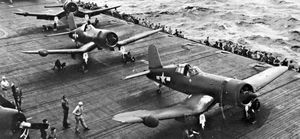
The Night Operations Carriers
During the summer of 1944, two types of USN night fighter units were formed: a four plane night fighter section of a regular daytime squadron, and a squadron made up of night fighters and torpedo planes that would fly from specially designated night operations carriers. The latter approach allowed pilots and FDOs who were familiar with each other to work together at all times. The first carrier designated as a night ops carrier would be the light carrier Independence that drilled her pilots and FDOs during August and September. Her team brought down three Japanese planes on the night of 12 October 1944 in operations near Formosa, and from the sixteenth through the end of October they ran fifteen night intercepts, of which they scored seven kills. [13, p.34]
In early October a U.S. fast carrier task force struck blows at Okinawa, Formosa, and the Philippines in rapid sequence, and drew a number of Japanese aerial counter attacks by land based planes. These attacks were usually at night or at sunset when the attackers could approach out of the setting sun. They were usually composed of numerous bombers and torpedo planes, sometimes with fighter escort. At night one or two leaders would illuminate the target ships with running lights or flares to guide the others in for a coordinated attack. In this manner the cruiser Canberra was torpedoed on the night of 13 October, followed by a torpedo into the cruiser Houston the next night. In both cases there was no night CAP aloft. The Third Fleet FDO wrote the attacks were “the worst problem of all.”
Until sunset, day fighters provided task force cover, and at sunset a large CAP of sixteen to twenty-four fighters, including eight night fighters would be launched. The night fighters worked in pairs; one VHF channel would be assigned to each pair, and each pair would be controlled by a separate FDO. The night carrier Independence sailed separated from the main fleet body, with her own CAP and surface escort, so she could launch and recover her night fighters without interfering with task force operations. Usually at night, two destroyer pickets would be placed about fifty miles from the main body in the direction from which attack was expected, and each would have control of two night fighters. They could give early attack warning, conduct intercepts on their own, and even make attackers think they had found their primary target. [13, p.36]
By late 1944, the night fighter pilots, and their equipment, were getting better. In the first six months of the year the average distance at which a night fighter first made bogey contact was 1.7 miles, whereas in the last six months the average increased to 2.8. As an another example, on the night of 14 December 1944, as a fast USN carrier task force stole in for an air attack on Luzon in the Philippines, a Japanese patrol plane was detected on Enterprise’s radar. A night fighter was launched and the snooper was in the water within seventeen minutes of detection. It was apparently jumped even before it could get off a contact message, allowing the task force to reach launch point undetected. The two night carriers Enterprise and Independence were assigned to operate together starting in January 1945 to form the first night operations task group. In mid-January, while Carrier Task Force 38 was entering the South China Sea through the Bashi Channel, Independence night fighters shot down three snoopers in one night. The new Commander Task Force 38, Vice Admiral J. S. McCain, thought highly of the night carriers and he wrote in his action report of the Japan operation:
When the number of carriers permits the assignment of one carrier to exclusive night duties, the results have been exceptional. The relief of other carriers from night duties, plus the use of the specially trained night groups for special night tactical and defense missions are very advantageous.
McCain's action report continued:
No efforts were made by the Japanese to attack our forces at night even though our location was known, even though the Japanese had many planes within range, and even though they had many suicide-bound pilots wanting nothing more than to crash their planes into one of our major units. During the entire time that Task Force 38 operated off Japan, no Japanese attacked these forces at night.
[24] [13, p.36]
In January 1945, the Japanese again began mounting serious dusk attacks on the fast carrier task force at Linguyan Gulf in the Philippines. Commander Seventh Fleet noted:
...thirty percent of the damaging suicide attacks occurred between the hours of 1700 and 1800....Sunset for this period was at 1740. This shows the Jap’s preference for attacking a half hour before sunset when he can use the sun’s glare to cover up his approach, and when our combat air patrol is being recovered.
If the fighter direction ships had been equipped with SM or SP height finding radar they might have been able to detect the incoming low fliers, but such was not the case. The night fighters seemed to be more effective against individual snoopers than against large attacks. Enterprise night fighters, on the night of seventeen/eighteen March downed two more patrol planes. The Japanese again used ‘deceiving paper’ on the night of 20 March to allow a number of snoopers to avoid intercept. [13, p.35]
Back to Day Carriers
Enterprise was out of action due to battle damage for most of April and May 1945, causing senior officers to reassess the costs and benefits of a dedicated night operations carrier. At the end of May, as Commander Task Force 58, Admiral Halsey wrote:
A single night carrier such as Enterprise is not dependable to protect the whole force. A night-carrier assigned to each task force would be a solution, but such an employment of carriers would result in a decrease in the overall offensive potential of the Fast Carrier Task Forces. Therefore, it is recommended that each CV be equipped with 6 VF(N) and 6 VT(N) type aircraft, and that consideration be given to the discontinuation of the night carrier program as such.
By mid-March, Japanese aircraft were again attacking the fast carrier task force heavily during the daytime, as well as continuing night attacks. However, the night attacks were no longer as intense or as well directed. They were not seen as a serious threat to a well maneuvered force, and from 18 March to 25 May Task Force 58 night fighters shot down ninety-one aircraft. In his Okinawa invasion action report, Admiral Halsey pointed out that most of this success was due to night fighter detachments on the day carriers rather than night-carrier aircraft. He wrote, the success was due to:
- A rigid force control of the number of VF(N) airborne (not more than 4).
- Shifting of control (oftentimes control was passed to 2 or 3 bases before interception resulted in a kill).
- Excellent maintenance on the part of all carriers.
- Good night controlling.
[13, pp.35-36]
Also conducting night fighter interceptions in the immediate Okinawa invasion area were three amphibious force flagships having SP height finding radars, as well as five ground intercept control radar sites ashore with height finding capability. Picket destroyers with fighter direction teams were also stationed around the island and they participated in night fighter direction. In all, the various night fighter direction teams in the invasion area from 30 March to 17 May ran 252 night intercepts, of which eighteen resulted in kills. One reason for the comparatively low kill ratio was pointed out by the Task Force 58 FDO as due to breaking off many intercepts as the night fighters came within range of shore and ship AA batteries, one of the principal responsibilities of the night fighter director. [13, p.36]
Click here to go to “Island Hopping - Chapter 12 of Radar and the Fighter Directors.”
